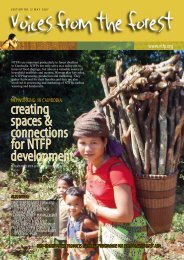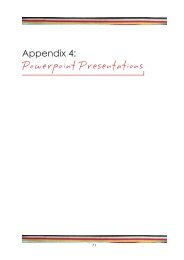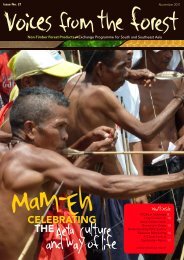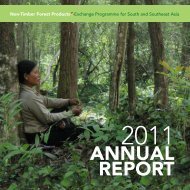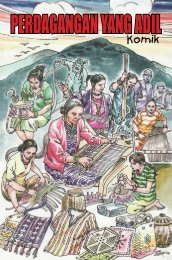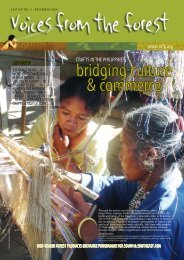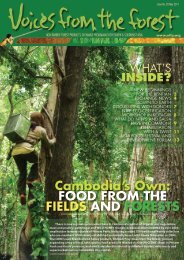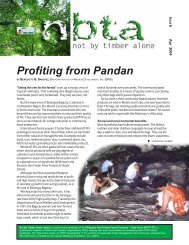Download PDF: NTFP-EP_Cambodia_Resin_Report.pdf
Download PDF: NTFP-EP_Cambodia_Resin_Report.pdf
Download PDF: NTFP-EP_Cambodia_Resin_Report.pdf
You also want an ePaper? Increase the reach of your titles
YUMPU automatically turns print PDFs into web optimized ePapers that Google loves.
Stakeholder Forum on Sustainable and<br />
Pro-Poor Oleoresin Industry Development<br />
in <strong>Cambodia</strong><br />
23 September 2011<br />
Himawari Hotel<br />
Phnom Penh, <strong>Cambodia</strong><br />
I. Overview of the Forum<br />
Dipterocarp oleoresins or balsams are important products in the rural economy and a source<br />
of income for a great number of (mostly indigenous) collectors in Southeast Asia including<br />
<strong>Cambodia</strong>. In <strong>NTFP</strong>-<strong>EP</strong>’s resin trade chain study in 2009, it was found that over 17,000<br />
households (or about 100,000 individuals) depend on resin tapping as their primary source<br />
of cash income (averaging US$350 per household per annum). The resins are locally<br />
employed for waterproofing boats and baskets, while lower grades are used as fuel for<br />
torches. There is also a thriving resin trade intra-region. About 3,500 tonnes of the total<br />
annual harvest is used domestically where it provides key inputs to the vital and crisisresistant<br />
fishing industry, 1 while an estimated average of 11,000 tonnes per annum is<br />
exported, mostly to Vietnam, with no value addition premium (<strong>NTFP</strong>-<strong>EP</strong>, 2009). Based on<br />
the same research, Preah Vihear and Mondulkiri provinces rank as the top 2 contributors of<br />
<strong>Cambodia</strong>’s total resin production; up to 10,000 tonnes in Preah Vihear and up to 3,000<br />
tonnes from Mondulkiri. 2 The current annual value of unprocessed resin exports from<br />
<strong>Cambodia</strong> to Vietnam is between US$4.7 to US$7.6 million. A much smaller volume finds its<br />
way to Thailand and (for re-export) Laos. Meanwhile, a growing, though currently still<br />
modest volume of resin originating in Southeast Asia enters the manufacture of high end<br />
natural varnishes and paints, produced in Germany and elsewhere in the European Union. As<br />
well, there is an increasing global call for “greener, fairer and sustainable” economies to<br />
which natural and fairly traded products, in general, are provided with market entry points.<br />
For example, with the growing overall interest worldwide in truly ecological products, there<br />
appears to be considerable, albeit so far untapped, potential to develop the household and<br />
industrial applications, as well as other possible niche markets of dipterocarp resins such as<br />
natural paints, varnish and glue, and essential oil and balsams for both domestic and<br />
international markets.<br />
The <strong>Cambodia</strong> <strong>NTFP</strong> Working Group (CNWG) in cooperation with the Non-Timber Forest<br />
Products Exchange Programme of South and Southeast Asia (<strong>NTFP</strong>-<strong>EP</strong>) have been, since<br />
2007, building a knowledge and partnership base for the development of sustainable<br />
management and marketing of dipterocarp resins in <strong>Cambodia</strong>. With support from the UN-<br />
MDGF Creative Industries Support Programme, local NGO members of the <strong>Cambodia</strong> <strong>NTFP</strong><br />
Working Group have undertaken sustainable and community based resin enterprise<br />
development project initiatives in 7 villages in two provinces, Mondulkiri and Preah Vihear.<br />
This entailed community organizing and business support to community resin<br />
groups/associations. Additionally, under the same CISP support, <strong>NTFP</strong>-<strong>EP</strong> took the<br />
facilitation role in the commercialization and value chain development of resins from the<br />
project target areas within a 10-month period. This role involved:<br />
• Developing through a participatory process sustainable/quality resin tapping<br />
protocols and standards<br />
1 An estimated 350,000 wooden fishing boats ply the inland waters of <strong>Cambodia</strong>. All these boats need regular caulking. In<br />
addition, fishing crews increasingly use resin torches for lighting at night, as a substitute for either kerosene lamps or battery<br />
fueled torches. The lower resin grades used for the latter purpose would otherwise be considered waste material. Luu, T.H. et<br />
al. (draft July 2009). <strong>Resin</strong> Studies in Vietnam (Hochiminh City: CBD and <strong>NTFP</strong>-<strong>EP</strong>), found that tree resins are also widely<br />
used for caulking the boats in Vietnam’s fishing fleet.<br />
2 Prom Tola (2009). Beyond Subsistence: Trade Chain Analysis of <strong>Resin</strong> Products in <strong>Cambodia</strong>. (Phnom Penh: <strong>NTFP</strong><br />
Exchange Programme).<br />
5



